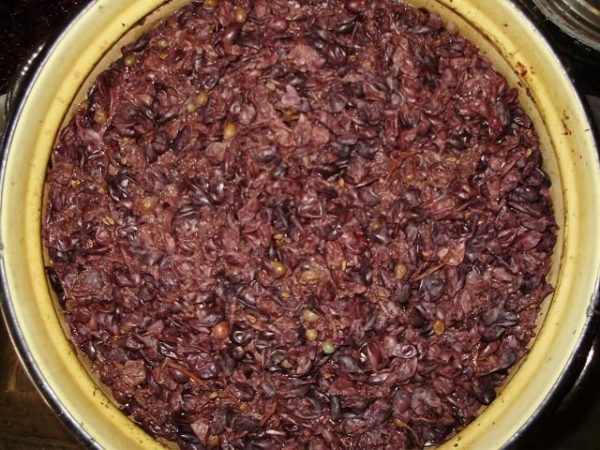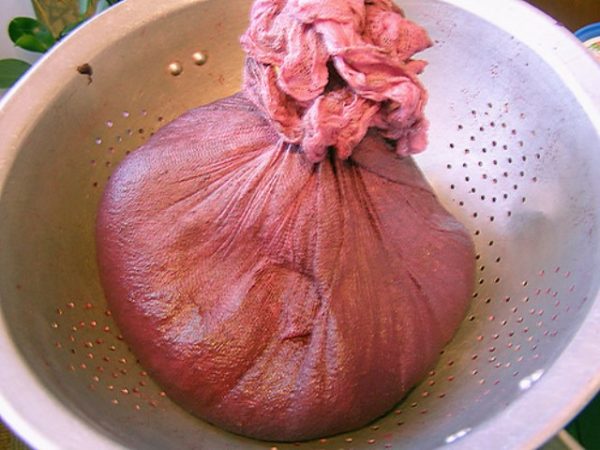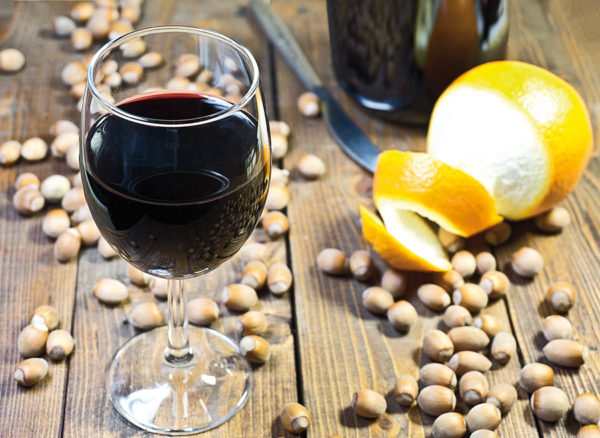In the manufacture of wine at home remains secondary raw material - pulp. It is a compressed mixture of grape seed and fruit residues obtained as a result of the primary extraction of the juice from the fruit. Grapeseed meal contains a lot of nutrients and secondary wine obtained from this material, although it will not be as rich in color and taste, but will contain a fairly high amount of useful components.
Table of contents
Quality of secondary wine from oilcake
Made from recycled wine is undoubtedly inferior in quality, richness and aroma to a drink made from pure juice of grape fruits. When pressing the fruit, the coloring elements contained in the pulp and skin are separated., so the secondary drink will be softer and lighter taste, more watery, the aroma will be less saturated.
How to make a second wine from dark grapes at home
From dark varieties produce a red drink, characterized by rich color and aroma. After fermentation, the pulp is squeezed and used in the manufacture of the secondary beverage. The whole secret is that even after pressing in the pulp remains from 1 to 6% of sugar, trace elements responsible for the fermentation process and a lot of nutrients.
Adding to the pulp water and sugar, thereby activating the fermentation process. If the production of secondary wine was originally planned, in this case the pulp should not be pressed until dry. The pulp remaining after the primary spin for digestion must be delivered no later than the first day, and ideally immediately after the spin to prevent the process of acetic souring.The bones during spinning must remain intact, otherwise crushed bones will give bitterness to taste.

When cooking, use:
- pressed cake-ten liters;
- water — seven liters;
- sugar — one and a half kilograms.
Cooking method:
- Extractions should be placed in an enameled pan for fermentation.
- From sugar mixed with cold water, prepare a syrup and pour pulp over it;
- The container must remain one third empty, so that there is a place for fermentation in it;
- On the neck of the bottle a water seal is installed. It is a tube, threaded from one end into the cork on the neck of the bottle, and the other end is lowered into a jar of water. If there is no water seal, you can use a glove. Need to put it on the bottle and pierce one finger with a needle;
- The bottle with the wort is placed in a dark place at a temperature of 19 to 27 degrees. The temperature should be stable;
- After the passage of twelve hours it is necessary to stir the wort. To do this, remove the stopper, stir the bottle with a clean wooden stick;
- Pop-up skin needs to be embedded in a liquid;
- After 24 hours, a foam cap appears on the surface and a hiss will be heard. This means that the fermentation process has begun;
- If fermentation has not begun, or is sluggish, add yeast or unwashed grapes;
- After 14 days, when the pulp becomes brighter, it is necessary to strain the obtained liquid, using gauze for this, squeeze and pour into another bottle. This process must be controlled, as the ossicles in the squeeze after 15 days begin to secrete prussic acid, which is a poison;
- Fermentation time from the time of preparation is from 25 to 55 days. At the end of the fermentation process, the glove on the neck will fall, and a precipitate forms at the bottom;
- Young wine is carefully poured using a tube into another container, trying not to affect the sediment. If necessary, add sugar and fix with vodka or alcohol. To fix the alcohol take from 5 to 15% of the total amount of wine. Alcohol improves storage, but the taste will be harder.
- To hold the bottle filled with a drink to the very edges, so that it is not in contact with air. Tightly close the bottle and transferred to a dark place with a temperature of 5 to 16 degrees.A cellar is suitable for storage, in which the bottle is left for six months.
- Every ten days in the presence of sediment, the liquid is drained through a tube into another container and tightly closed.
- In the absence of sediment in the bottle, it is bottled and sealed tightly.
- Fortress 10-12%. You can keep it for 2 years.

How to make a secondary wine from the pulp of white grapes
White wine is fermented on the juice, without the addition of pulp. After squeezing the juice in the cake there are a lot of nutrients and microorganisms that contribute to fermentation.
The process of obtaining secondary wine:
- Pour the cake in an enameled container and pour water in a ratio of 1: 1. The mass of oil cake and water should fill the container with no more than 2/3 of the volume so that there is a place for fermentation.
- For fermentation, place the container in a dark room with a temperature of 18-25 degrees. The temperature must be kept constant at the same level.
- Fermentation of oilcake occurs from 5 to 8 days.The process of fermentation must be monitored in order not to miss the moment of the beginning of fermentation.
- The cake in the tank needs to be constantly mixed and the peel that has risen to the surface is sunk in the juice. This is done to ensure that the top layer does not stagnate, and the wine does not turn into wine vinegar.
- If fermentation has not begun, or it is weak, in this case a handful of raisins or unwashed grapes is added.
- When the fermentation begins to fade, this mass is filtered, squeezed, poured into the bottle.
- In the resulting wort, you must add sugar at the rate of 1 kilogram per 10 liters of wort. After 7 days add the same mass of sugar.
- The fermentation process will be active, so the shutter set at this stage should not be. Cover the neck of the bottle with folded gauze.
- After 10 days, you must wear a medical glove on the neck and pierce the hole with a needle on one finger. So that the glove does not come off during fermentation, it must be fixed on the neck with a rope or duct tape.
- After 30 days from the moment the second portion of sugar is added to the drink, it should be carefully drained through a tube into another bottle so that the sediment remains at the bottom.
- Put the glove on the tank with the wort flow and leave to ferment for another 30 days.
- Re-strain after a month in another container and leave in a dark room for clarification for another two months.
- In the process of clarification is formed the taste of the drink. If the taste is satisfied, then you can perform a quick clarification procedure. To do this, pour the product into plastic bottles and put it in a room with a temperature slightly above -5 degrees. At this temperature, the wine will quickly brighten, and a precipitate forms at the bottom.

With such a technique, it is possible to make a secondary wine fragrant, with a pleasant taste, there is nothing comparable to the primary wine in taste characteristics, which is prepared from the juice at home. Please yourself with such a pleasant drink or even tincture!
